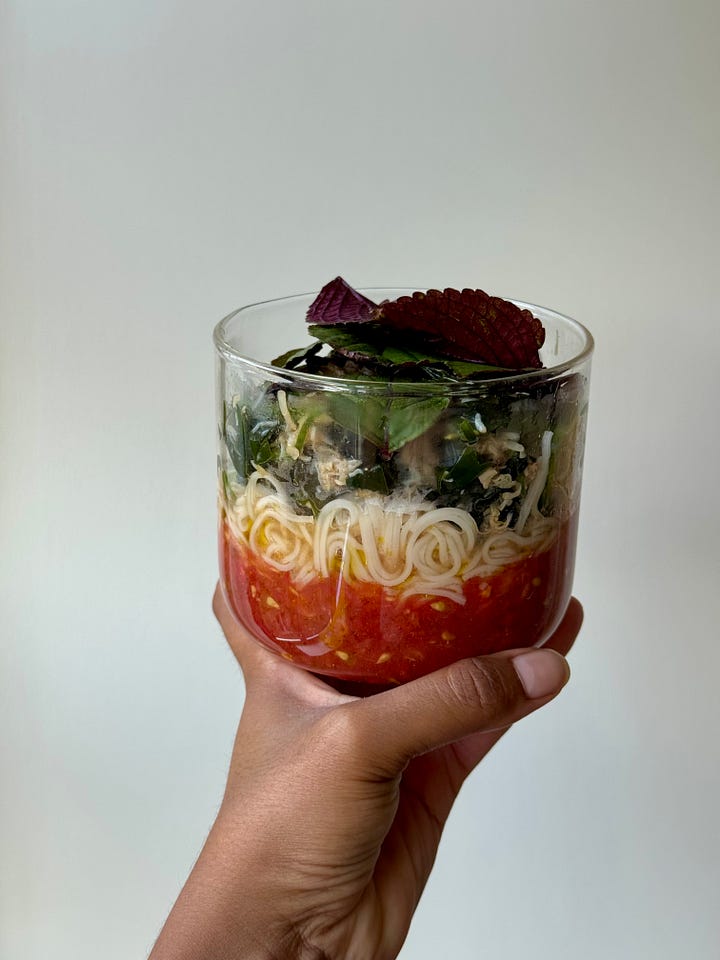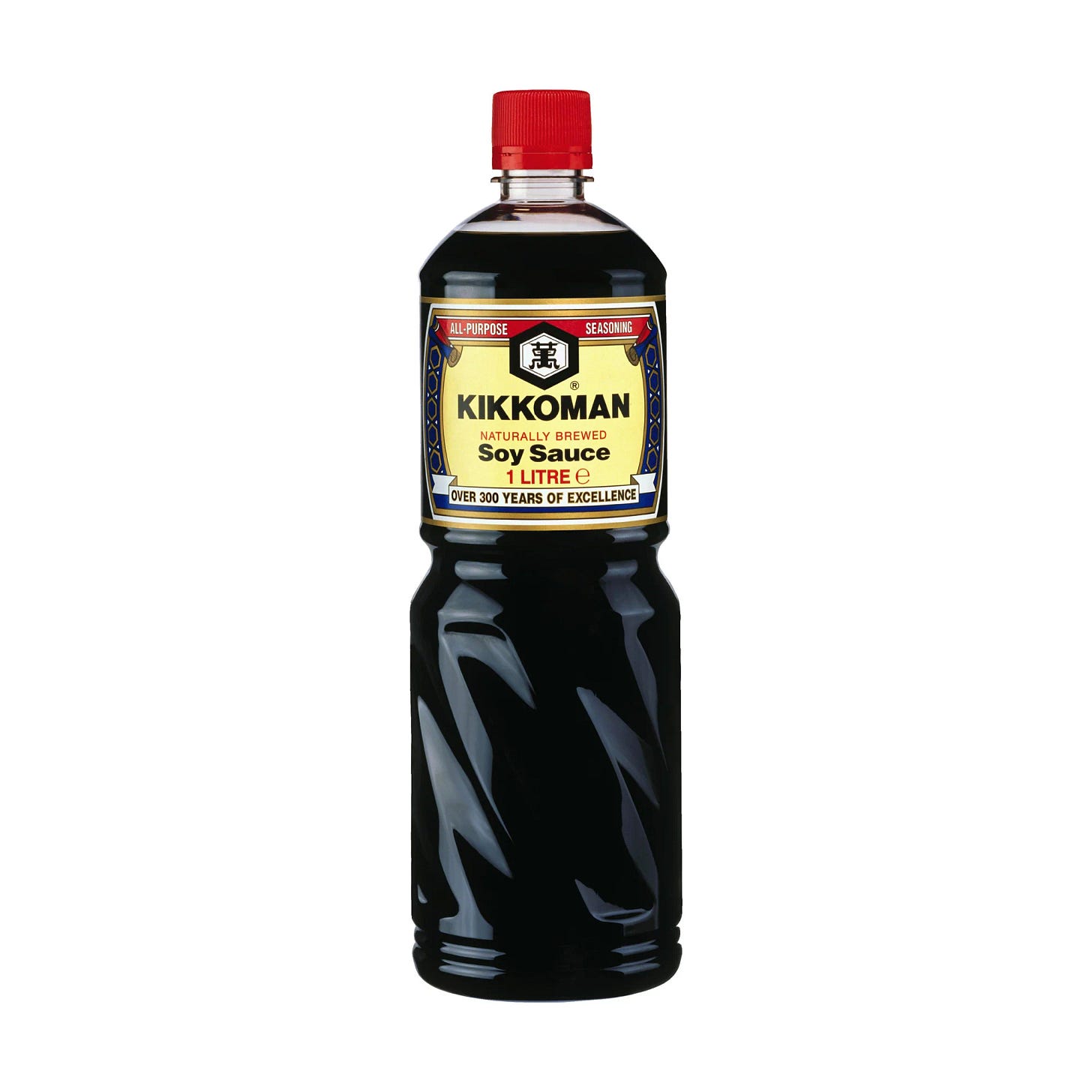Soy Sauce 101 & a fresh noodle Salad
When to use different types of soy sauces and a perfect salad that barely requires any cooking.
Hi!
I hope summer has been treating you well, wherever you are in the world, and the produce has been beautiful and bountiful.
I thought I would share with you a very basic breakdown of soy sauce (it makes sense for the recipe) - because not all soy sauces are created equal, and not all are interchangeable.
**The breakdown will be basic, and cover what is largely available in Western supermarkets.**
The base of soy sauce is made by fermenting cooked soy beans (and sometimes wheat), then adding that into a salt brine solution to continue fermenting until its ready to strain, pasteurise and bottle.
If I would guess, when most people think of soy sauce, they’re thinking of Kikkoman (all-purpose naturally brewed) - call this Shoyu (which just means soy sauce in Japan, but its important to differentiate! )
This specific shoyu is made with a even ratio of soybean and wheat - It’s the most versatile (can be used both in raw and cooked processes, braises, dipping sauces, dressings etc..) and makes for a slightly sweeter product. If you want to get more technical, this type of Japanese soy sauce is referred to as koikuchi (dark Japanese soy sauce).
We don’t have the luxury of having all the different types of Japanese soy sauces in our supermarkets (koikuchi, usukuchi, shiro, saichikomi…) but the other version we can easily get our hands on is Tamari (this is probably because of a higher demand for gluten free products.)
Tamari is the byproduct of miso production. The liquid is a soy sauce-like product: richer, slightly stronger in flavour, and thicker in texture than shoyu. Not all tamari nowadays are 100% g/f, so if you need it to be, check the labels.
Let’s get into the most basic Chinese soy sauces. Most likely, you’ll only find 2 kinds: light and dark.
Light Chinese soy sauce is the more expensive one - It’s ‘fresh,’ made from the first pressing, which results in a saltier, and thinner consistency. It’s the one most commonly used in Chinese cooking - use it just like you would salt and pepper (to season.) It belongs in everything: marinades, soups, broths, stir-fry, fried rice… just don’t use as much as you would shoyu.
Dark Chinese soy sauce is very different - It’s thicker than the latter and most of the time lightly sweetened with a little molasses or sugar. You gravitate to this condiment, when you’re looking to enrich, gently sweeten and darken/colour a dish.
There are so many other soy sauces out there, but the last I will touch on is a sweet soy sauce - The one we can usually find is called Kecap manis, which comes from Indonesia. Infused with aromatics, spices and sweetened with palm sugar- this product is a lot more viscous and syrupy in texture, and almost like a bittersweet caramel… but, it’s still just as versatile as shoyu. Use it in marinades, as a glaze, in stews, stir-fry, fried rice (nasi goreng), as a finishing condiment, whatever your heart desires.
There are so many different brands of soy sauces out there. All I ask is for you to LEAVE THE WESTERN SUPERMARKET OWN BRAND SOY SAUCES ON THE SHELVES. They suck.
Here are some of the soy products I use:
Clearspring Japanese Organic Shoyu Soya Sauce
Kikkoman Traditionally Brewed Marudaizu Shoyu Soy Sauce
Kikkoman all-purpose naturally brewed
Kikkoman Naturally Brewed Tamari Gluten free Soy Sauce
Dek Som Boon Light Soy Sauce (Thai)
Pearl River Bridge Superior Light Soy Sauce (Chinese)
Pearl River Bridge Superior Dark Soy Sauce (Chinese)
By now, this condiment has probably become a staple in your household, but knowing how to differentiate between the different products will bring your cooking to the next level.
Onto the recipe!
Crab & Seaweed Salad with Tomato Somen


This recipe is what you make when you don’t want to feel the heat of cooking. It’s quick, requires so little effort and also makes incredible leftovers.
Serves: 2
Prep/Cooking Time: 15-20 minutes
Subs:
Switch out shiso for any soft herbs you like: chives, coriander, parsley, thai basil…
Any thin noodles you like will also work perfectly.
You can easily omit the crab to keep it vegan/vegetarian.
To make this gluten-free: substitute the noodles for 100% buckwheat/soba noodles, or with rice noodles (halving the amount.) Change soy sauce to gluten-free tamari, and season to taste (you’ll probably have to add a little less than stated.)
Ingredients
15 Dried Wakame
200g Somen Noodles
½ Cucumber, thinly sliced or mandolined
100g White Crab Meat
5g Shiso, leaves picked, stalks discarded
For the Salad Dressing:
2 Tbsp Shoyu Soy Sauce
1 Tbsp Rice Vinegar
½ Lemon
2 Tbsp Olive Oil
2 Tsp Honey
For the Dressing:
400g Tomatoes
2 Tbsp Rice Vinegar
2 Tbsp Olive Oil
½ Tbsp Shoyu Soy Sauce
Ingredients
Add the wakame into a medium bowl and fill with water. Set aside to rehydrate.
In another bowl make the tomato dressing: Halve the tomatoes, and coarsely grate the flesh, discarding the skin. Then, stir through the rest of the ingredients. Taste and season with more vinegar, shoyu or salt. Set aside.
In a large bowl, zest the lemon and stir the salad dressing ingredients together. Taste and season with more honey, shoyu or lemon juice, if needed - It should be quite a punchy dressing.
Fill a saucepan with salted water and bring to the boil. Once boiling, drop the somen in and cook according to package instructions. Drain and wash under cold water until cool to the touch, let fully drain.
Drain the wakame and squeeze the water out. Toss the seaweed, cucumber and crab through the salad dressing.
When ready to eat, spoon the tomato dressing onto the bottom of your bowl. Top with the noodles, crab salad and shiso.




